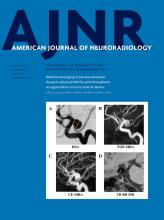Abstract
BACKGROUND AND PURPOSE: Much has been written about the initial radiologic features of cavernous malformations, but less known are the radiologic natural history and evolution of the lesions, particularly when they initially present with hemorrhage. We aimed to describe the typical evolution of a sporadic, hemorrhagic brain cavernous malformation with time.
MATERIALS AND METHODS: From our institutional review board–approved cavernous malformation registry, we assessed initial clinical and radiologic features and the subsequent MR imaging evolution of 51 patients with sporadic, hemorrhagic brain cavernous malformations (with follow-up brain MRIs available for review).
RESULTS: The initial MR imaging demonstrated mostly Zabramski type I lesions (94.2%) with T1 hyperintensity (94.2%) and associated edema (76.5%). Eight patients (15.6%) rebled in the first year with lesions characterized by new T1 hyperintensity (100%), edema (61.5%), and growth (median, 4 mm). By 90 days, most lesions had changed from Zabramski type I to type II or III (65.2%). While 76.5% had edema associated with the acute hemorrhage, none had persistent edema beyond 90 days unless rebleeding occurred. Across time, the frequency of T1 hyperintensity decreased from 94.2% at baseline to 73.9%, 57.1%, and 50.0% at <90, 91–365, and >365 days. DWI intensity at baseline and <90, 91–365, and >365 days was hypointense at 53.1%, 56.5%, 70.1%, and 81.2%, respectively.
CONCLUSIONS: Hemorrhagic cavernous malformation demonstrates a characteristic pattern of evolution on follow-up imaging. Knowing this evolution helps to analyze the timing of imaging in relation to the clinical presentation and may help distinguish true cavernous malformation hemorrhagic evolution from mimics and guide appropriate timing of interval-imaging follow-up after symptomatic bleeds in untreated patients.
ABBREVIATIONS:
- CM
- cavernous malformation
- DVA
- developmental venous anomaly
- © 2019 by American Journal of Neuroradiology
Indicates open access to non-subscribers at www.ajnr.org












